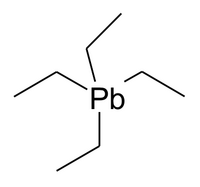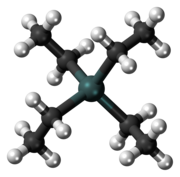This is an old revision of this page, as edited by Beetstra (talk | contribs) at 12:36, 10 January 2012 (Saving copy of the {{chembox}} taken from revid 469799758 of page Tetraethyllead for the Chem/Drugbox validation project (updated: '').). The present address (URL) is a permanent link to this revision, which may differ significantly from the current revision.
Revision as of 12:36, 10 January 2012 by Beetstra (talk | contribs) (Saving copy of the {{chembox}} taken from revid 469799758 of page Tetraethyllead for the Chem/Drugbox validation project (updated: '').)(diff) ← Previous revision | Latest revision (diff) | Newer revision → (diff)| This page contains a copy of the infobox ({{chembox}}) taken from revid 469799758 of page Tetraethyllead with values updated to verified values. |

| |

| |
| Names | |
|---|---|
| IUPAC name Tetraethylplumbane | |
| Other names
Lead tetraethyl Tetraethyl lead | |
| Identifiers | |
| CAS Number | |
| 3D model (JSmol) | |
| Abbreviations | TEL |
| Beilstein Reference | 3903146 |
| ChEBI | |
| ChemSpider | |
| EC Number |
|
| Gmelin Reference | 68951 |
| MeSH | Tetraethyl+lead |
| PubChem CID | |
| RTECS number |
|
| UNII | |
| UN number | 1649 |
InChI
| |
SMILES
| |
| Properties | |
| Chemical formula | C8H20Pb |
| Molar mass | 323.4 g·mol |
| Appearance | Colorless liquid |
| Density | 1.653 g cm |
| Melting point | −136 °C (−213 °F; 137 K) |
| Refractive index (nD) | 1.5198 |
| Structure | |
| Molecular shape | Tetrahedral |
| Dipole moment | 0 D |
| Hazards | |
| NFPA 704 (fire diamond) |
 |
| Flash point | 73 °C |
| Related compounds | |
| Except where otherwise noted, data are given for materials in their standard state (at 25 °C , 100 kPa).
| |
Chemical compound